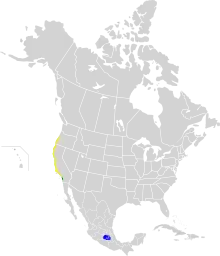Allen's hummingbird
Allen's hummingbird (Selasphorus sasin) is a species of hummingbird. It is a small bird, with mature adults reaching only 3 to 3.5 in (76 to 89 mm) in length. The male has a green back and forehead, with rust-colored (rufous) flanks, rump, and tail. The male's throat is an iridescent orange-red. The female and immature Allen's hummingbirds are similarly colored, but lack the iridescent throat patch, instead having a series of speckles on their throats. Females are mostly green, featuring rufous color only on the tail, which also has white tips. Immature Allen's hummingbirds are so similar to the female rufous hummingbird, the two are almost indistinguishable in the field. Both species' breeding seasons and ranges are common factors used to differentiate between the two species in a particular geographical area.
| Allen's hummingbird | |
|---|---|
 | |
| Adult male | |
| Scientific classification | |
| Kingdom: | Animalia |
| Phylum: | Chordata |
| Class: | Aves |
| Order: | Apodiformes |
| Family: | Trochilidae |
| Genus: | Selasphorus |
| Species: | S. sasin |
| Binomial name | |
| Selasphorus sasin (Lesson, 1829) | |
 | |
| Range of S. sasin Breeding range Year-round range Wintering range | |
Distribution
Allen's hummingbird is common only in the brushy woods, gardens, and meadows of coastal California from Santa Barbara north, and southern coastal Oregon. The nominate race of Allen's hummingbird, S. s. sasin, is migratory, and winters along the Pacific coast of central Mexico. A second, S. s. sedentarius, is a permanent resident on the Channel Islands off southern California. This population colonized the Palos Verdes Peninsula of Los Angeles County in the 1960s and has since spread over much of Los Angeles and Orange Counties, south through San Diego County, and east to the western end of Riverside County.
Behavior
.jpg.webp)
The courtship flight of male Allen's hummingbirds is a frantic back-and-forth flight arc of about 25 ft (7.6 m) similar to the motion of a swinging pendulum, followed by a high-speed dive from about 100 ft (30 m) during which tail feathers emit a characteristic sharp flutter to further attract attention of the female.[2] Aggressive and territorial, male Allen's hummingbirds will chase any other males from their territory, as well as any other hummingbird species, and have even been known to attack and rout predatory birds several times larger than themselves, such as kestrels and hawks.
Allen's hummingbird constructs its nest out of plant fibers, down, and weed stems, coating the nest with lichens and spider webs to give it structure. The nest is placed above ground on a tree branch or the stalk or stem of a plant. The female lays one or two white eggs, which she incubates for 15 to 17 days. The young leave the nest about three weeks after hatching. The mother continues to feed the fledglings for several more weeks, then the young are left to fend for themselves.
Like all hummingbirds, Allen's hummingbird's high rate of metabolism requires it to feed frequently. It drinks nectar from flowers and eats any small insects in flight or on flower blossoms, providing needed protein.
Name
The common name commemorates Charles Andrew Allen, an American collector and taxidermist who first identified the bird in 1879 in Nicasio, California.[3]
A hybrid between this species and Anna's hummingbird has been described as Floresi's hummingbird, "Selasphorus" floresii.[4][5]
Gallery
 Feeding
Feeding Adult female tending a nest
Adult female tending a nest.jpg.webp) Juvenile male or female
Juvenile male or female In art
In art
References
- BirdLife International (2012). "Selasphorus sasin". IUCN Red List of Threatened Species. 2012. Retrieved 26 November 2013.CS1 maint: ref=harv (link)
- Clark, C. J. (2014). "Harmonic Hopping, and Both Punctuated and Gradual Evolution of Acoustic Characters in Selasphorus Hummingbird Tail-Feathers". PLOS ONE. 9 (4): e93829. doi:10.1371/journal.pone.0093829. PMC 3983109. PMID 24722049.
- Bendire, Charles (1895). Life Histories of North American Birds, from the Parrots to the Grackles. Washington, DC, USA: U.S. Government Printing Office. p. 217. LCCN 03018191.
- Ridgway, Robert (1909). "Hybridism and Generic Characters in the Trochilidae" (PDF). Auk. 26 (4): 440–442. doi:10.2307/4071292. JSTOR 4071292.
- Taylor, Walter P. (1909). "An instance of hybridization in hummingbirds, with remarks on the weight of generic characters in the Trochilidae" (PDF). Auk. 26 (3): 291–293. doi:10.2307/4070800. JSTOR 4070800.
External links
| Wikimedia Commons has media related to Selasphorus sasin. |
| Wikispecies has information related to Selasphorus sasin. |
- Live Allen's hummingbird nest webcam at Phoebe Allen's Hummingbird Webcam
- "Allen's hummingbird media". Internet Bird Collection.
- Gallery of Allen's Hummingbirds in flight taken with high speed flash
- Allen's hummingbird photo gallery at VIREO (Drexel University)
- BirdLife species factsheet for Selasphorus sasin
- "Selasphorus sasin". Avibase.

- Interactive range map of Selasphorus sasin at IUCN Red List maps
- Audio recordings of Allen's hummingbird on Xeno-canto.
